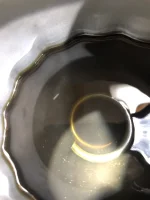Propflux01
$100 Site Donor 2025
Got a friend that wanted me to change oil on his Harley. When I drained it, it had lots of metal shavings, looking not unlike that of light metallic paint. He was running a WIX 57148 filter. He asked me why there was stuff in the oil, that shouldn't the filter have taken that out, and the oil be relatively clearer. I couldn't give him an answer. So it got me thinking, am I looking at this wrong or ?
Now, the bypass pressure of this filter is 8 PSI. We hooked up a gauge to this engine and ran it till it got pretty hot. At 3k RPM oil pressure was 45 PSI, idle was 15PSI. Now is this filter even filtering at these pressures, or only under 8PSI? Or is the filter allowing 8PSI through, and the rest through its bypass, only partially filtering the oil? And if neither is the case, why did we see metal at all in the oil, instead of a clogged filter? WE cut the filter open, and it really doesn't show much of anything in it. It just seems to me, that I should have seen those particles in the filter, rather than the oil. And since I can see them, I will assume they are larger than 20 Microns. What am I missing here?

Now, the bypass pressure of this filter is 8 PSI. We hooked up a gauge to this engine and ran it till it got pretty hot. At 3k RPM oil pressure was 45 PSI, idle was 15PSI. Now is this filter even filtering at these pressures, or only under 8PSI? Or is the filter allowing 8PSI through, and the rest through its bypass, only partially filtering the oil? And if neither is the case, why did we see metal at all in the oil, instead of a clogged filter? WE cut the filter open, and it really doesn't show much of anything in it. It just seems to me, that I should have seen those particles in the filter, rather than the oil. And since I can see them, I will assume they are larger than 20 Microns. What am I missing here?


